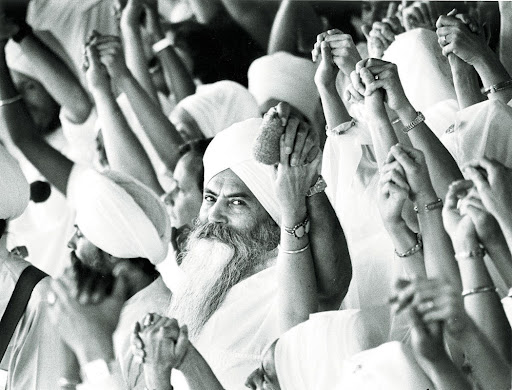
The California Media Machine: How Kundalini Yoga Was Hyped, Harpooned, and Hung Out to Dry (3HO)
Kundalini Yoga's trajectory in the West is a textbook case of how the California media machine, a relentless engine of hype, commodification, and moral panic, chews up spiritual movements and spits them out. From its countercultural roots to its celebrity-fueled peak and its abrupt fall from grace, Kundalini's story reveals a pattern that has repeated for decades: discovery, distortion, and disposal.
What makes this cycle so predictable? And why does the media machine keep getting away with it, regardless of who gets shamed or exposed?
1. The Rise: From Underground Practice to Luxury Brand
1960s–70s: Counterculture's Fast-Path Spirituality
Kundalini Yoga arrived in America at the perfect time, when disillusioned hippies, burned out on politics and psychedelics, craved instant enlightenment. Yogi Bhajan, a savvy marketer as much as a spiritual teacher, positioned Kundalini as the "yoga of the Aquarian Age", promising rapid awakening through breathwork, chanting, and intense kriyas. Unlike slower, more disciplined traditions, Kundalini offered quick results, making it ideal for the spiritually impatient.
1980s–90s: Celebrity Endorsement & Media Glamorization
By the Reagan era, Kundalini had shed its countercultural edge and become a status symbol. Celebrities like Madonna, Demi Moore, and Russell Brand turned it into "Hollywood's secret weapon", a blend of mysticism and detox culture. Media outlets, particularly California-based wellness magazines (Yoga Journal, GOOP), amplified this image, framing Kundalini as deeper, more esoteric, and more elite than mainstream yoga.
The message was clear: This wasn't just exercise, it was enlightenment for sale.
2. The Peak: Commercialization and the Cult of the Guru
Branding Spirituality: 3HO and the Wellness Industrial Complex
Kundalini didn't just grow, it corporatized. Under the banner of 3HO (Healthy, Happy, Holy Organization), it merged Sikh aesthetics (white turbans, sat nam chants) with New Age capitalism. Teacher trainings cost thousands, retreats became luxury experiences, and Silicon Valley executives paid top dollar for "elevated consciousness", all while Bhajan amassed wealth and influence.
The Guru Problem: Centralized Power, Inevitable Scandal
Unlike decentralized yoga styles (Vinyasa, Ashtanga), Kundalini was entirely tied to Yogi Bhajan's authority. This made it vulnerable. For years, whispers of abuse, financial exploitation, and authoritarian control circulated, but the media, which had helped build the brand, looked the other way.
Why? Scandal wasn't profitable yet.
3. The Fall: Media Pivot and the Ritual Discarding
2020: The Exposés Hit
Once Bhajan was dead and the market had squeezed Kundalini dry, the same outlets that once glorified it (The Atlantic, BuzzFeed) published damning investigations. Allegations of sexual assault, financial fraud, and cult-like control turned the practice from "divine science" to "dangerous dogma" overnight.
The Machine Moves On
With Kundalini now "tainted," the wellness industry didn't miss a beat. The same influencers who once posted about their "Kundalini awakenings" pivoted to:
- Wim Hof breathwork (the new "biohacking" spirituality)
- Psychedelic retreats (shamanism for tech bros)
- "Trauma-informed" yoga (repackaged mindfulness for the therapy generation)
Kundalini wasn't wrong, it was just used up.
Why This Keeps Happening
The California Media Playbook
- Hype: Find an exotic practice, strip it of context, sell it as "the next big thing."
- Exploit: Turn it into courses, retreats, merch, monetize the mysticism.
- Discard: When scandals emerge or trends shift, act shocked and move on.
Consumer Spirituality's Hunger for Quick Fixes
The West doesn't want tradition, it wants fast, intense, Instagrammable transcendence. Kundalini delivered until the media decided it was "problematic." The next Eastern import (Tantra? Qi Gong?) will face the same fate.
The Guru Trap
Any movement built around a single charismatic leader is doomed in the West. The media loves gurus, until it's time to burn them.
Conclusion: The Machine Always Wins
Kundalini Yoga didn't fail. The system worked exactly as designed. The California media machine doesn't care about truth, tradition, or transformation, it cares about cycles of consumption.
Today, it's Kundalini. Tomorrow, it'll be something else. The players change, but the game stays the same.
The only question left:
Who's next?
Download Torrent: Yogi Bhajan, Kundalini Yoga, 3HO, Khalsa Sikhs (50 Books)
The California Media Machine's Next Targets
1. Breathwork Fascism
2. Psychedelic Minimalism
3. AI Guru Grifts
4. Trauma Capitalism
5. Neo-Tantra™ (Again, But Worse)
6. Eco-Anxiety Yoga
7. Crypto-Zen
Bonus: The Machine's Playbook
- Identify a practice with spiritual depth or grassroots authenticity.
- Strip it of context, commodify its aesthetics.
- Amplify via celebrity endorsements and pseudo-science.
- Monetize through luxury retreats, apps, and merch.
- Discard when the backlash outweighs the profit.